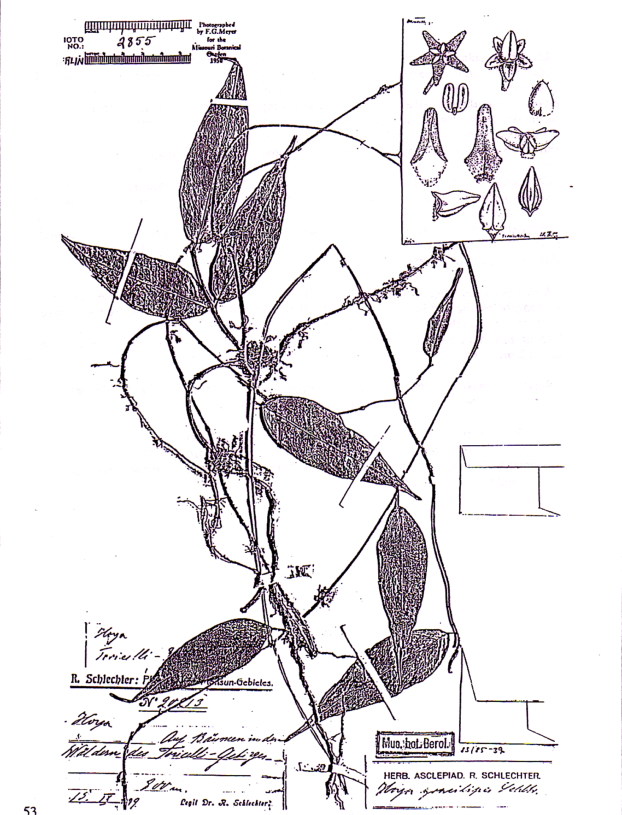
Hoya gracilipes Schlechter 1905
Type description:
In Nachtrage zur Flora der Deutschen Schutzgebeite in der Südsee (1905) 363 K. Schumann & K Lauterbach. H. gracilipes Schlechter n. sp. Epiphytica in truncis arborum, alto scandens ramosa; ramis ramulisque filiformibus, flexuosis, teretibus, glabris, laxe foliatis, interdum radicantibus; foliis patentibus patulisve lanceolatis vel el1iptico-lanceolatist acuminatis; utrinque glabris, textura coriaceis, breviter 7.5—10 cm longis, infra medium 2—3 cm latis, petiolo 0.4—0.7 cm longo; pedunculis, gracillimus teretibus vulgo 4.5—5.5 cm 1ongis, glabris, rhachide paulo incrassata; pedicellis filiformibus, glabris, ca. 2 cm longis; umbellis 8—12‑floris; calycis segmentis oblongis obtusis, margine minute ciliatis, caeterum glabris, ca. 1.5 mm longis; corolla rotata 1.2 cm diametiente, usque ad medium 5-lobata, extus glabra intus dense et brevissime granuloso‑puberula, lobis ovatis subacutis, margine recurvis, 0.5 cm longis; corona carnosa foliolis horizontalibus, ovatis obtusis, apice breviter et acute rostatis, medio longitudinaliter sutbcarinato-incrassatis, subtus (dorso) ovatis, longitudinaliter sulcatis; antheris 1ate trapozoideis, appendice hyalina ovata breviter acuminata; pollinis oblongis dimidio longitudinaliter incrassatis, translatoribus brevibus, retinaculo obtuso, basi exciso, polliniis multo minora; stigmatis capite breviter conico.
Kaiser Wilhelmsland; Auf Bäumen in den Wäldern des Torricelli‑Gebirges, alt. ca. 1100 m (R. Schlechter, n. 14478, bl. April 1902).
Eine sehr characteristische Art, die sich durch den sehr schlanken Habitus, wie durch die dünnledrigen Blätter und die äuszerst schlanken Stiele der Blütendoldea vor allen anderen Arten leicht unterscheiden 1äszt.
Translation: same as in “Dr. Schlechter’s Hoya Species” below.
Other literature:
In Botanische Jahrbücher (1908) 120-121. R. Schlechter. (Engler’s). 26. H. gracilipes Schltr., in K. Schum. u Lauterb., Nactr. (1905 p. 363).
Nordöstl. Neu-Guinea: auf baümen in den Wäldern des Torricelli Geberges, ca 800—1100 m ü M. (Schlechter n. 14478. — Blühend im April 1902; n. 20213.— Blühend im September 1909).
Hier liegt weider ein typisches Beispiel dafür vor, wie lokal viel Arten breitet sind. Gerade auf dem Torricelli-Giberge Habe ich viele Arten wiedergefunden, welch ich früher dort in anderen Gegenden gesammelt hatte, die aber auf den übrigen Gebigen zu fehlen scheinen. H. gracilipes Schltr. schlieszt sich am nächsten an H. solaniflora Schltr., ist aber durch die weiszen Blüten und die viel schmäleren, auszen dast spitzen koronaschuppen verschieden.
Translation: see entry below.
In Hoyas of Northeastern New Guinea (1992) 53-54. R. D. Kloppenburg. (Translation of Die Asclepiadaceen von Deutsch-Neu-Guinea. 26. Hoya gracilipes Schlechter in K. Schumann and Lauterbach, Addendum (1905) p.363.
Northeastern New guinea: on trees in the forest of the Torricelli Mountains about 800-1100 m. altitude (Schlechter #14478 - Blooming in April 1902; #20213 - Blooming in September 1909).
Here again lies a typical example of how many species are locally disseminated. In the Torricelli Mountains I have again found many species which I earlier had collected in different regions, but which did not appear to occur on the remaining mountain chain. H. gracilipes Schlechter is nearest to H. solaniflora Schlechter but is different in its white blooms and the much diminished corona scales, and the corona scales that are much narrower and pointed on the outside (outer apex).
In The Asclepiadaceous Works of Friedrich Richard Rudolf Schlechter (1992) 30. A. Nicholas. H. gracilipes Schlechter (Schlechter 14478) – 14.
In Dr. Schlechter’s Hoya Species (1993) 70-71. R. D. Kloppenburg. Hoya gracilipes Schlechter 1905 Nachtrage zur Flora der Deutschen Schutzgebeite in der Südsee p. 363 (K. Schumann und K. Lauterbach).
Epiphytic on the trunks of trees, high climbing, branched, branches rebranched, threadlike, flexible, round, glabrous, loosely leaved, occasionally rooting; leaves spreading outspread, lanceolate or elliptic-lanceolate acuminate, both sides glabrous, texture leathery, shortly petiolate, 7.5-10 cm. long, below the middle 2-3 cm. wide. petiole 0.4-0.7 cm. long; with the pedicels very slender. round, glabrous, about 2 cm. long; with umbels 8-12 flowered; with the segments of the calyx oblong obtuse, margins minutely ciliate, otherwise glabrous, about 1.5 mm. long; corolla rotate 1.2 cm. in diameter, 5 lobed all the way to the middle, outside glabrous, inside densely and briefly granulous-puberulous, lobes ovate somewhat acute, margins recurved, 0.5 cm. long; corona fleshy, scales horizontal, ovate obtuse, apex short and acutely beaked, in the middle longitudinally somewhat keeled thickened, on the back ovate, longitudinally sulcate, with the anthers broadly trapezoidal, with the appendages hyaline ovate briefly acuminate; with the pollinia oblong gradually longitudinally thickened, translators small, retinaculum obtuse, base excised, many times smaller than the pollinia, with the head of the stigma conic.
Northeast New Guinea (Kaiser Wilhelmsland): On trees in the forest of the Torricelli Mountains, altitude about 1100 meters (R. Schlechter #14478 flowering in April 1902).
A very characteristic species distinguished in its slight appearance from any other species through its very slender habit and through the very thin leaves and narrowly slender peduncles of the umbel.
Hoya gracilipis Schlechter, 1908, # 20213 (B)

